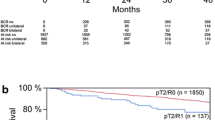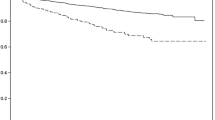Abstract
Objectives
The objective of this study was to evaluate the significance of capsular incision (CI) at radical prostatectomy (RP) for men with prostate cancer.
Materials and methods
This study included 267 men who underwent RP without neoadjuvant therapy and were pathologically diagnosed as having organ-confined disease. CI was defined as exposing benign or malignant glands at the inked margin without documented extraprostatic extension.
Results
Pathological examinations identified CI in 53 RP specimens (19.9%), while CI was not detected in the remaining 214 specimens (80.1%). The locations of CIs in RP specimens from these 53 patients were as follows: 39 (73.6%) at the apex, 11 (20.0%) at the anterior site, 4 (7.5%) at the posterior site and 12 (22.6%) at the bladder neck. The incidence of CI was significantly affected by surgical procedure, preoperative serum PSA and microvenous invasion in RP specimen. During the observation period of this study, biochemical recurrence occurred in 10 (18.9%) of the 53 with CI and 20 (9.3%) of the 214 without CI, and the biochemical recurrence-free survival in patients with CI was significantly poorer than those without CI. Furthermore, of several factors examined, biochemical recurrence was significantly associated with preoperative serum PSA, Gleason score, perineural invasion and capsular incision, among which only preoperative serum PSA appeared to be an independent predictor of biochemical recurrence.
Conclusions
Despite the lack of independent significance, the presence of CI has an adverse impact on biochemical outcome in patients undergoing RP for clinically localized prostate cancer.

Similar content being viewed by others
References
Hull GW, Rabbani F, Abbas F et al (2002) Cancer control with radical prostatectomy alone in 1, 000 consecutive patients. J Urol 167:528–534. doi:10.1016/S0022-5347(01)69079-7
Graefen M (2006) The positive surgical margin after radical prostatectomy—why do we still not really know what it means? Eur Urol 50:199–201. doi:10.1016/j.eururo.2006.02.016
Khan MA, Partin AW (2005) Surgical margin status after radical retropubic prostatectomy. BJU Int 95:281–284. doi:10.1111/j.1464-410X.2005.05282.x
Chang SS, Cookson MS (2006) Impact of positive surgical margins after radical prostatectomy. Urology 68:249–252. doi:10.1016/j.urology.2006.03.053
Barocas DA, Han M, Epstein JI et al (2001) Does capsular incision at radical retropubic prostatectomy affect disease-free survival in otherwise organ-confined prostate cancer? Urology 58:746–751. doi:10.1016/S0090-4295(01)01336-X
Ohori M, Wheeler TM, Kattan MW et al (1995) Prognostic significance of positive surgical margins in radical prostatectomy specimens. J Urol 154:1818–1824. doi:10.1016/S0022-5347(01)66792-2
Boccon-Gibod L, Ravery V, Vordos D et al (1998) Radical prostatectomy for prostate cancer: the perineal approach increases the risk of surgically induced positive margins and capsular incisions. J Urol 160:1383–1385. doi:10.1016/S0022-5347(01)62543-6
Cheng L, Darson MF, Bergstralh EJ et al (1999) Correlation of margin status and extraprostatic extension with progression of prostate carcinoma. Cancer 86:1775–1782. doi:10.1002/(SICI)1097-0142(19991101)86:9<1775::AID-CNCR20>3.0.CO;2-L
Chuang AY, Nielsen ME, Hernandez DJ et al (2007) The significance of positive surgical margin in areas of capsular incision in otherwise organ confined disease at radical prostatectomy. J Urol 178:1306–1310. doi:10.1016/j.juro.2007.05.159
Shuford MD, Cookson MS, Chang SS et al (2004) Adverse prognostic significance of capsular incision with radical retropubic prostatectomy. J Urol 172:119–123. doi:10.1097/01.ju.0000132137.02846.ec
Epstein JI (1996) Incidence and significance of positive margins in radical prostatectomy specimens. Urol Clin North Am 23:651–663. doi:10.1016/S0094-0143(05)70343-8
Watson RB, Civantos F, Soloway MS (1996) Positive surgical margins with radical prostatectomy: detailed pathological analysis and prognosis. Urology 48:80–90. doi:10.1016/S0090-4295(96)00092-1
Huland H, Hammerer P, Henke RP et al (1996) Preoperative prediction of tumor heterogeneity and recurrence after radical prostatectomy for localized prostatic carcinoma with digital rectal, examination prostate specific antigen and the results of 6 systematic biopsies. J Urol 155:1344–1347. doi:10.1016/S0022-5347(01)66262-1
Walsh PC (1994) Radical prostatectomy: a procedure in evolution. Semin Oncol 21:662–671
Koch MO (2000) Management of the dorsal vein complex during radical retropubic prostatectomy. Semin Urol Oncol 18:33–37
Guillonneau B, Vallancien G (2000) Laparoscopic radical prostatectomy: the Montsouris technique. J Urol 163:1643–1649. doi:10.1016/S0022-5347(05)67512-X
Hara I, Kawabata G, Miyake H et al (2002) Feasibility and usefulness of laparoscopic radical prostatectomy: Kobe University experience. Int J Urol 9:635–640. doi:10.1046/j.1442-2042.2002.00530.x
LinksHu JC, Gold KF, Pashos CL et al (2003) Role of surgeon volume in radical prostatectomy outcomes. J Clin Oncol 21:401–405. doi:10.1200/JCO.2003.05.169
Eastham JA, Kattan MW, Riedel E et al (2003) Variations among individual surgeons in the rate of positive surgical margins in radical prostatectomy specimens. J Urol 170:2292–2295. doi:10.1097/01.ju.0000091100.83725.51
Terakawa T, Miyake H, Tanaka K et al (2008) Surgical margin status open versus laparoscopic radical prostatectomy specimens. Int J Urol (in press)
Author information
Authors and Affiliations
Corresponding author
Rights and permissions
About this article
Cite this article
Kumano, M., Miyake, H., Muramaki, M. et al. Adverse prognostic impact of capsular incision at radical prostatectomy for Japanese men with clinically localized prostate cancer. Int Urol Nephrol 41, 581–586 (2009). https://doi.org/10.1007/s11255-008-9467-z
Received:
Accepted:
Published:
Issue Date:
DOI: https://doi.org/10.1007/s11255-008-9467-z




